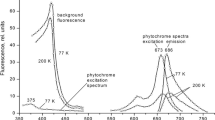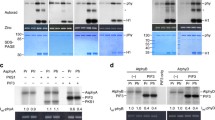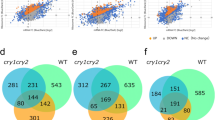Abstract
Polyclonal antibodies against pea phytochrome detect 2 protein bands (about 116 and 120 kDa) on blots of crude protein extracts and protein of microsomal preparations of dark-grown tomato seedlings. Both protein bands are undetectable in Western blots of the aurea mutant extracts. Neither protein band is detectable after isogenic wild-type seedlings are illuminated with 3 h of red light, either in the crude extract or in the membrane fraction of the irradiated seedlings; this result is consistent with the hypothesis that both bands are phytochrome. When dark-grown wild-type seedlings are illuminated with 3 h of red light or blue light against a red light background, the transcript levels for chlorophyll a/b-binding proteins of photosystem I and II, plastocyanin, and the subunit II of photosystem I increase. In all cases, the same fluence rate of blue light is much more effective than red light alone, a result that indicates the involvement of a blue/UV-A light photoreceptor in addition to the involvement of the far-red-absorbing form of phytochrome, Pfr. The aurea mutant responds neither to red light nor to blue light. Thus, no Pfr-independent induction of the four transcripts by a blue/UV-A light photoreceptor can be measured in the aurea mutant.
Similar content being viewed by others
Abbreviations
- pb:
-
base pairs
- BL:
-
blue light
- cab-PSI:
-
chlorophyll a/b-binding protein of photosystem I
- cab-PSII:
-
chlorophyll a/b-binding protein of photosystem II
- Chl:
-
chlorophyll
- D:
-
darkness
- PC:
-
plastocyanin
- Pfr:
-
far-red light absorbing form of phytochrome, physiologically active
- Pr:
-
red light absorbing form of phytochrome, physiologically inactive
- rbcS:
-
small subunit of ribulose-1,5-bisphosphate carboxylase
- RL:
-
red light
- SDS:
-
sodium dodecyl sulfate
References
Adamse P, Kendrick RE, Koornneef M: Photomorphogenetic mutants of higher plants. Photochem Photobiol 48: 833–841 (1988).
Adamse P, Jaspers PAPM, Baker JA, Wesselius JC, Heeringa GH, Kendrick RE, Koornneef M: Photophysiology of a tomato mutant deficient in labile phytochrome. J Plant Physiol 133: 436–440 (1988).
Adamse P, Peters JL, Jaspers PAPM, van Tuinen A, Koornneef M, Kendrick RE: Photocontrol of anthocyanin synthesis in tomato seedlings: a genetic approach. Photochem Photobiol (in press).
Bradford M: A rapid and sensitive method for the quantitation of microgram quantities of protein utilizing the principle of protein-dye binding. Anal Biochem 72: 248–254 (1976).
Coruzzi G, Broglie R, Cashmore AR, Chua N-H: Nucleotide sequences of two pea cDNA clones encoding the small subunit of ribulose-1,5-bisphosphate carboxylase and the major chlorophyll a/b-binding thylakoid polypeptide. J Biol Chem 258: 1399–1402 (1983).
Cordonnier M-M, Pratt LH: Comparative phytochrome immunochemistry as assayed by antisera against both monocotyledonous and dicotyledonous phytochrome. Plant Physiol 70: 912–916 (1982).
Drumm-Herrel H, Mohr H: Mode of coaction of phytochrome and blue light photoreceptor in control of hypocotyl elongation. Photochem Photobiol 40: 261–266 (1984).
Drumm-Herrel H, Mohr H: Mode of coaction between UV-A and light absorbed by phytochrome in control of appearance of ribulose-1,5-bisphosphate carboxylase in the shoot of milo (Sorghum vulgare Pers.). Photochem Photobiol 47: 599–604 (1988).
Goeschl JD, Pratt HK, Bonner BA: An effect of light on the production of ethylene and the growth of the plumular portion of etiolated pea seedlings. Plant Physiol 42: 1077–1080 (1967).
Feinberg AP, Vogelstein B: A technique for radiolabeling DNA restriction endonuclease fragments to high specific activity. Anal Biochem 132: 6–13 (1983).
Fluhr R, Chua N-H: Developmental regulation of two genes encoding ribulose-bisphosphate carboxylase small subunit in pea and transgenic petunia plants: phytochrome response and blue-light induction. Proc Natl Acad Sci USA 83: 2358–2362 (1986).
Fluhr R, Moses P, Morelli G, Coruzzi G, Chua N-H: Expression dynamics of the pea rbc S multigene family and organ distribution of the transcripts. EMBO J 5: 2063–2071 (1986).
Gaba V, Black M: Photoreceptor interaction in plant photomorphogenesis: the limits of experimental techniques and their interpretations. Photochem Photobiol 45: 151–156 (1987).
Gaba V, Black M, Attridge TH: Photocontrol of hypocotyl elongation in de-etiolated Cucumis sativus L. Plant Physiol 74: 897–900 (1984).
Gallagher S, Short TW, Ray PM, Pratt LH, Briggs WR: Light-mediated changes in two proteins found associated with plasma membrane fractions from pea stem sections. Proc Natl Acad Sci USA 85: 8003–8007 (1988).
Hoffman NE, Pichersky E, Malik VS, Castresana C, Ko K, Darr SC, Cashmore AR: A cDNA clone encoding a photosystem I protein with homology to photosystem II chlorophyll a/b-binding polypeptides. Proc Natl Acad Sci USA 84: 8844–8848 (1987).
Hoffman NE, Pichersky E, Malik VS, Ko K, Cashmore AR: Isolation and sequence of a tomato cDNA clone encoding subunit II of the photosystem I reaction center. Plant Mol Biol 10: 435–445 (1988).
Kaufman LS, Thompson WF, Briggs WR: Phytochrome-induced accumulation of RNA encoding the small subunit of RuBPCase requires ten thousand fold more red light than does the RNA for the chlorophyll a/b binding protein. Science 226: 1447–1449 (1984).
Koornneef M, Cone JW, Dekens RG, O'Herne-Robers EG, Spruit CJP, Kendrick RE: Photomorphogenic responses of long hypocotyl mutants of tomato. J Plant Physiol 120: 153–165 (1985).
Kronenberg GHM, Kendrick RE: Phytochrome: the physiology of action. In: Kendrick RE, Kronenberg GHM (eds) Photomorphogenesis in Plants, pp. 547–564. Martinus Nijhoff, Dordrecht (1986).
Marrs KA, Kaufman LS: Blue-light regulation of transcription in nuclear-encoded genes in pea. Proc Natl Acad USA 86: 4492–4495 (1989).
Mohr H, Drumm-Herrel H, Oelmüller R: Coaction of phytochrome and blue/UV light photoreceptors. In: Senger H (ed) Blue Light Effects in Biological Systems, pp. 6–19. Springer, Berlin/Heidelberg (1984).
Mohr H: Coaction between pigment systems. In: Kendrick RE, Kronenberg GHM (eds) Photomorphogenesis in Plants, pp. 547–564. Martinus Nijhoff, Dordrecht (1986).
Oelmüller R, Briggs WR: Intact plastids are required for nitrate- and light-induced accumulation of nitrate reductase activity and mRNA in squash cotyledons. Plant Physiol (in press).
Oelmüller R, Conley PB, Federspiel N, Briggs WR, Grossman AR: Changes in accumulation and synthesis of transcripts encoding phycobilisome components during acclimation of Fremyella diplosiphon to different light qualities. Plant Physiol 88: 1077–1083 (1988).
Oelmüller R, Mohr H: Responsivity amplification by light in phytochrome-mediated induction of chloroplast glyceraldehyde-3-phosphate dehydrogenase (NADP-dependent, EC 1.2.1.13) in the shoot of milo (Sorghum vulgare Pers.). Plant Cell Environ 7: 29–37 (1984).
Oelmüller R, Mohr H: Mode of coaction between blue/UV light and light absorbed by phytochrome in light-mediated anthocyanin formation in the milo (Sorghum vulgare Pers.) seedling. Proc Natl Acad Sci USA 82: 6124–6128 (1985).
Parks BM, Jones AM, Adamse P, Koornneef M, Kendrick RE, Quail PH: The aurea mutant of tomato is deficient in spectrophotometrically and immunochemically detectable phytochrome. Plant Mol Biol 9: 97–107 (1987).
Pichersky E, Bernatzky R, Tanksley SD, Breidenbach RB, Kausch AP, Cashmore AR: Molecular characterization and genetic mapping of two clusters of genes encoding chlorophyll a/b-binding proteins in Lycopersicon esculentum (tomato). Gene 40: 247–258 (1985).
Schiff JA: A green safelight for the study of chloroplast development and other photomorphogenetic phenomena. Meth Enzymol 24: 321–322 (1972).
Sharrock RA, Parks BM, Koornneef M, Quail PH Molecular analysis of the phytochrome deficiency in an aurea mutant of tomato. Mol Gen Genet 213: 9–14 (1988).
Silverstone J, Tobin EM: Demonstration of transcriptional regulation of specific genes by phytochrome action. Proc Natl Acad Sci USA 81: 1112–1116 (1984).
Tobin EM, Silverthorne J: Light regulation of gene expression in higher plants. Ann Rev Plant Physiol 36: 569–593 (1985).
Author information
Authors and Affiliations
Rights and permissions
About this article
Cite this article
Oelmüller, R., Kendrick, R.E. & Briggs, W.R. Blue-light mediated accumulation of nuclear-encoded transcripts coding for proteins of the thylakoid membrane is absent in the phytochrome-deficient aurea mutant of tomato. Plant Mol Biol 13, 223–232 (1989). https://doi.org/10.1007/BF00016140
Received:
Accepted:
Issue Date:
DOI: https://doi.org/10.1007/BF00016140




